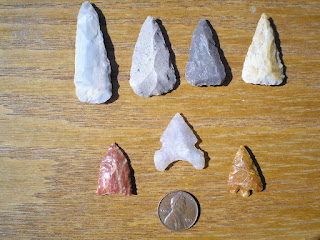
These points are all Colorado material from around Grand Junction. The toughest one to knap is the middle piece above the penny. Its untreated chalcedony. The two in the bottom row are common opal from Opal hill which is west of GJ. This stuff knaps like glass and is beautiful rock. Wish I had more. Again, I just let the rock decide what shape it would turn into.

Heres a picture of a nodule of Burlington as found on the shore of Truman Lake, Missouri. It has a thick cortex, or coating, which is kind of chalky.
 Heres an end shot of the nodule showing the chert interior. This is some fine knapping material. You can plainly see the cortex in this photo.
Heres an end shot of the nodule showing the chert interior. This is some fine knapping material. You can plainly see the cortex in this photo. Heres a super nice specimen of native copper crystals from the Upper Peninsula of Michigan. It was found at an old copper mine near Houghton. The American Indians used native copper for thousands of years to make tools. They traded a lot of it as can be seen in the contents of mounds and burials far away from the source.
Heres a super nice specimen of native copper crystals from the Upper Peninsula of Michigan. It was found at an old copper mine near Houghton. The American Indians used native copper for thousands of years to make tools. They traded a lot of it as can be seen in the contents of mounds and burials far away from the source. Heres a group of stone tools from North Africa. I bought them at the Tucson gem and mineral show. The dealer said these were from western Algeria. The top three are uniface blades. I really like the little points, especially the one on the left. I was a bit surprised to see these listed in Oversreets Arrowhead price guide. They're in the back of the book. These are going pretty cheap right now. I paid a dollar each. After the supply starts to dwindle they'll likely go way up in price. Get em while ya can if ya make it to Tucson in February!
Heres a group of stone tools from North Africa. I bought them at the Tucson gem and mineral show. The dealer said these were from western Algeria. The top three are uniface blades. I really like the little points, especially the one on the left. I was a bit surprised to see these listed in Oversreets Arrowhead price guide. They're in the back of the book. These are going pretty cheap right now. I paid a dollar each. After the supply starts to dwindle they'll likely go way up in price. Get em while ya can if ya make it to Tucson in February! Thanks for looking and enjoy!
Thanks for looking and enjoy!


6 comments:
Thanks so much for posting these pictures, Ron. I have never seen raw Burlington. Now if I get the chance to head up to Truman, I'll know what to look for.
hi ron, my name is danny and i'm trying to find some primitive skills classes in denver, or perhaps someone who is willing to teach what they know. if you know of anything, please let me know. agentk9000@yahoo.com.
I am wanting to learn flint knapping so bad! I'm sure there is plenty of chert around here, but I wouldn't know it if a chert rock hit me! That rock picture looks like just any ol' rock. How do you distinguish a flint rock from an ordinary rock?
The way to tel if a rock is flint or chert is to give it a glancing blow with another rock (I use my heavy copper bopper in the field for this)and spall off a flake. If the rock flakes and leaves concoidal fractures (like broken glass) there is a very good chance its flint or chert. The rock should look a bit glassy. If you have ever seen a piece of slag then you will have an idea of what to look for. Look on Paleo Planet forum at the chipped arrowheads and you'll see what a concoidal fracture is (the scars left on the arrowhead from flake removal are concoidal)and what the rock should look like.
Great info, my friend. I took my two boys to a creek bed nearby and I am pretty sure I found two chert nodules. One of them was broke showing the white chalky interior and a black/gray interior. I'll give it a "spall."
I meant chalky EXTERIOR and black/gray interior. . .sorry. . .
Post a Comment